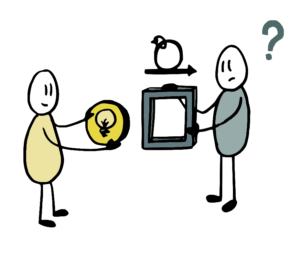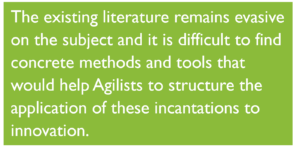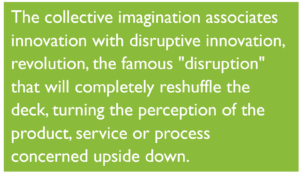Agility and innovation, from myth to reality (1/3)
This series of articles aims to shed light on the obvious yet complex link between Agility and innovation, and to suggest ways of structuring them. Although these two universes are often associated in the common imagination, their combined application is very rare. Why this paradox?

In the collective unconscious, Agile is an ideal breeding ground for innovation. But, if one of the objectives of your Agile transformation is to improve your ability to innovate, you should know that the path is not completely marked out because the literature is quite shy on the subject: teams wishing to combine these two worlds are often confronted with problems of structuring or adhesion, which can lead to failure and demotivation. Yet, innovation is a significant lever of performance and profitability for companies. So, how to reconcile Agile and innovation?
Through a trilogy of articles, Mews Partners proposes to analyze this paradox that links innovation and Agility and to bring convictions and concrete solutions, based on feedback from field experiences.
Throughout these articles, we will use Scrum and SAFe © as references, since they are the leaders of the most used Agile methods worldwide (see State of Agile report 2021). All the concepts and beliefs presented hereafter are transposable to all Agile teams, whatever their size and the method used.
From Agile philosophy to innovation
Agility is booming. And much more than a fashion, it convinces. Historically reserved for IT, it is now widely applied in industry and extends to the service sector. The number of practitioners and specialists is increasing proportionally to this expansion, and the methods are enriched by the diversity of practices and applications. The reasons for this transformation are many and varied: from the ability to manage changing priorities to the acceleration of time to market and the ability to innovate. On paper, Agile seems to be a tool adapted to each of these ambitions and to innovation with which it shares many common points: working with and for the customer and his needs, accepting to evolve in uncertainty, using prototypes to test the viability on the market of a product with minimal functionalities …
However, innovation remains an opportunity that is not well addressed in Agile. Neither the Manifesto, nor the different Agile methodologies explicitly mention it. Only the most widespread in terms of Agility at scale, SAFe ©, mentions it, placing innovation as a pillar of the Agile mindset. SAFe © advocates continuous exploration, analysis of the field and regular collection of feedback to enable the framing of innovation and to dedicate time to it during an “Innovation & Planning Sprint” (IP Sprint)… without however detailing the art and manner of inviting teams to explore new horizons.

Illustration of SAFe Model Timing ©
Despite this proven interest, the literature on the subject remains evasive, and it is difficult to find concrete methods and tools that would help Agilists structure the application of these innovation incantations.

Nevertheless, the promise of competitiveness linked to innovation is a hot topic of discussion in the office. Many people talk about it but few try it, and often with limited success. Essentially used as a buffer period for unfinished activities, sometimes as a place for retrospection, the famous Sprint IP rarely achieves the luster it deserves with a time dedicated to innovation. But innovation in Agile is not limited to this iteration at the end of the Program Increment (PI). All the fundamental concepts of Agile must be a fertile ground for innovation.
Let’s take the example of User Stories. As their name indicates, they are user experience oriented. They are functional expressions of a customer need and not a description of a concrete deliverable (such as a specification). From this point of view, User Stories give the development team the freedom to propose an innovative solution, without restricting the way in which the need is met. In practice, we see that the human brain is lazy (or efficient, depending on your point of view). Stuck by its cultural biases and the stereotypes that govern it, it will naturally gravitate towards a solution it already knows and leave itself little time to think differently.
But does the developer really have this time to think differently? They are certainly not prisoners of a rigid schedule with a strict sequence of activities to be respected. At the rhythm of the iterations, he sets his own objectives which, logically, are meant to be achievable. At least in theory. In the field, we see that developers are often too ambitious. Despite the recommendations and tips for keeping their workload manageable, teams tend to take on an excessive number of User Stories, leaving little room for reflection and innovation. Caught up in their daily routine, they have the iteration’s objectives in mind, and often opt for solutions that are already proven.
However, the very structure of Scrum Teams should be enough to guide us towards new ways of thinking. With the abolition of siloed team organizations and the advent of multidisciplinarity, co-design should reshuffle the design cards towards more innovation and the development of an end-to-end solution (E2E) until it becomes a reality. User Stories, still (too) frequently written as “expected result” rather than “functionality”, are intended for a single team skill (especially in hardwares) – or worse, for a single person. In fact, even if the Scrum Team will benefit from this multi-skill organization, silos are inevitably recreated within it, limiting the fruits of cross-fertilization.
As we can see, while Agile methods lay a sound theoretical foundation for innovation, the practice can be acrobatic. However, many organizations still have this ambition.
Innovation, for what purpose?

The question that arises is legitimate: why innovate? What benefits can be expected in an Agile environment? Why spend time on it when the teams are already struggling to finish the Users Stories of a backlog that never stops growing?
Let’s first go back to what we mean by innovation, because definitions differ according to contexts and points of view. At Mews Partners, we define innovation as a process by which we respond in a new way to the need(s) of a category of users, via the creation or evolution of a product (service/process/organization) or a market, while being part of a technological and economic reality.
This is the triptych that is systematically found in innovation methods: desirability (need), feasibility (technological), viability (economic).
Curiously, innovation is often considered out of reach, the prerogative of a few exacerbated visionaries such as Steve Jobs or Elon Musk. In fact, the collective imagination associates innovation with disruptive innovation, revolution, the famous “disruption” that will completely reshuffle the deck, turning the perception of the product, service or process concerned, or of the need itself, upside down. Quite an ambition. Quite a challenge. Enough to disconcert more than one…
However, innovation also takes other, more “incremental” forms (doesn’t that remind you of Agile vocabulary?). It is already a question of “taking your head off the handlebars”, of allowing yourself time to observe your environment from a different perspective and simply to think about new alternatives.
Everyone will benefit: the customer, first, who will be provided with more value, with different solutions that he or she had not even considered. Let’s take a moment to draw a parallel with a model that is still under-exploited despite its insightfulness: the Kano model. This model classifies customer needs according to the degree of satisfaction provided to the user. Instinctively, basic and performance needs are often addressed first, with immediate or almost immediate solutions. But the practice of innovation encourages us to leave this safe zone and to target attractive needs, i.e. needs that are not necessarily expressed by the customer, that are latent, or even unknown to the user himself. This is where the pockets of value are the most important and where there is a significant potential for differentiation that it would be a shame not to exploit.
Teams will also benefit from these periods of breathing and taking a step back during the continuous (and sometimes sustained) rhythm of Agile sprints. On the one hand, they are an opportunity to think about new topics, as we have seen, and therefore to get out of the usual context, to use different methods, often more playful (we will talk about this in a future article). On the other hand, by acquiring new reflexes, renewed creativity and learning from the experiments carried out, the teams also prove to be more efficient on the project (increased skills, improved well-being at work, more innovative solutions).
It is the organization that will develop a capacity for analysis, for taking a step back, and a certain flexibility that will be beneficial not only for developing new products, but also for improving its own functioning through the innovation of processes, methods and tools. It is a virtuous circle that is gradually being put in place.
As we have seen, if Agile and innovation are a priori made to get along because of many common values, their combination is not easy. In addition to an evasive literature that provides few concrete elements, the company will also have to deal with a biased perception or even circumspect teams. The challenge, as we will see in a future article, is to demystify innovation by setting a clear course and objectives, adapted to the team’s maturity, as well as a framework that encourages creativity.
THE “AGILITY AND INNOVATION, FROM MYTH TO REALITY” SERIES
– Barriers to innovation: demystifying them with Agile? (2/3)
– How do you take the plunge and structure Agile innovation? (3/3)








